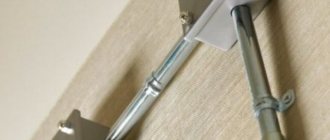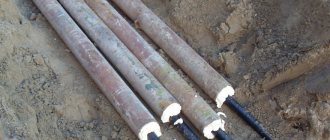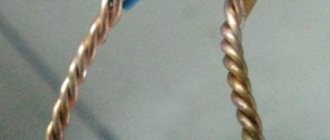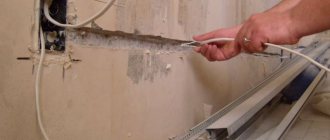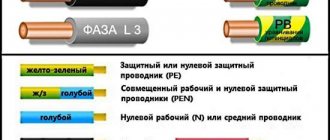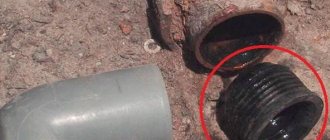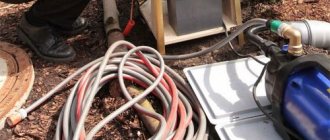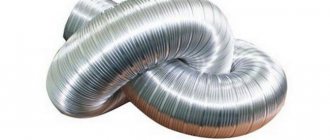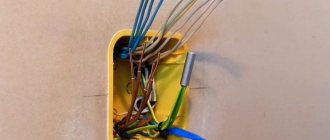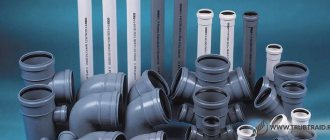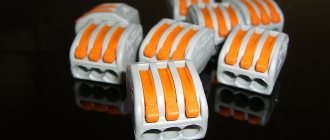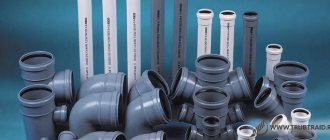When carrying out electrical installation work, it is often necessary to lay electrical wiring in an open way. To ensure protection of the electrical cable from mechanical influences, precipitation and other factors, to make a neat and aesthetic installation of power or low-current networks, a corrugated tube or, as it is also called, corrugation is used.
Why do you need corrugation?
Laying electrical cables and wires in corrugated areas is recommended for various reasons:
- When laid in flammable walls (wooden or frame), behind flammable finishing (lining, PVC boards), when attached to wooden floors - for fire safety reasons. In this case, non-combustible shells are chosen.
- When laying behind finishing materials - behind lining, plasterboard, PVC boards, etc. - for security reasons. To make it more difficult to damage the cable when trying to hang something on the wall. In this case, the most important indicator is the hardness of the shell.
Corrugated pipes for electrical wiring come in different colors. It's for a reason, colors have meaning. - When laying cables in a screed or under the floor, under finishing, corrugation is used for several purposes. Firstly, to protect against compression when pouring concrete. Secondly, to be able to change the cable if it is damaged without destroying the floor. Third, to protect against damage.
- When laying externally, the sheath is needed to protect the cable from atmospheric influences (ultraviolet) and mechanical damage. When laying open through the air, a corrugation with a wide temperature range (to withstand heat and frost) and durability are required. to ultraviolet. If the cable is suspended, reinforcement is also necessary to increase the load-bearing capacity.
- When laying underground, water resistance as well as rigidity are important.
When laying rigid corrugation on turns, it is better to use special couplings
In general, corrugation, even metal, is not the best protection against mechanical destruction. You can only hope that if you feel that the drill has failed, you will be able to stop in time. And in order to definitely not get into the electrical wiring, it is better to have an exact plan for its installation with measurements and reference to the corners. After all, not every wiring detector detects a corrugated cable, even under load. So, before pouring the screed, before finishing, don’t forget to take photographs, sketches and mark distances.
Is it possible to replace a cable with a rope?
In short, it’s impossible. The rope does not have the necessary properties and qualities, since when exposed to negative environmental factors, fabric products quickly fail. The rope is stretchable, easily frays and breaks. Due to low strength, sagging occurs, and a wire break will create an electrical and fire hazard.
Cable wiring installation technology
Theoretically, installing cables over the air is easier than organizing underground communications. However, in practice it involves meeting important requirements and performing work that only qualified and experienced electricians can do. The slightest mistakes can lead to a decrease in the safety of the cable line, so it is recommended to contact professional technicians for at least a consultation.
Types of corrugations for laying cables
Corrugated cables are available in different strengths:
- Easy. It has a thin wall and the highest degree of flexibility. Recommended for installation under cladding in walls and ceilings. Doesn't hold mechanical load well.
- Average. A little thicker than light, but not as stiff as heavy. Can be used in walls and screeds. They are good for walls, but it is better to lay heavy corrugation in the screed.
This is a double-walled corrugation - ribbed on the outside, smooth on the inside. It makes re-tightening the cable no problem. - Heavy. The walls are thick, flexibility is low. You can lay it in a screed or bury it in the ground. For turns, it is better to use angles or special couplings, since the minimum bending radius is quite large. They provide a normal degree of protection both in terms of moisture and dust resistance.
- Reinforced. Plastic sheaths are applied over twisted steel wire. This is the best option for laying in the ground and for hanging.
As you can see, the classification is based on strength properties, which determines the area of use.
Varieties
In addition to all this, there is also corrugation with and without broaching. A broach is a thin cable or wire that makes it easier to tighten the cable into the corrugation. The cable is tied to the end of the cable, pulled at the other end, tucking the cable inside. Without pulling it will be difficult to cope with this task - with sufficient rigidity, several meters of cable can simply be pushed inside, but if the route is long, this will be too difficult.
The cable corrugation can be with a broach (the correct name is “probe”) or without
If we talk about the types of plastic corrugation, we must mention that there is a two-layer corrugation. On the outside it has the same ribbed surface, but on the inside it is smooth. Corrugation for a cable of this type is expensive, but if necessary, you can actually stretch a new cable into it. In those events where the inner wall is ribbed, this is not always possible - if the track has a minimum of turns, and even those over a wide radius.
Metal and metal-polymer corrugation
Metal corrugation for cables also varies. It is made of galvanized or stainless steel. In addition, there is a metal corrugation with a polymer coating. It has the best characteristics for protection against dust and moisture. This protective shell is also called metal-polymer.
Changeability of wiring
If you think that by laying all the wiring in the corrugation you can easily and simply change it if necessary in the future, then you are again mistaken.
Here we can talk about replacement only for cables on absolutely flat areas. For example, in a straight line from one junction box to another, or a descent from the junction box under the ceiling to the socket box below.
Once you take at least one turn at an angle of 90 degrees on the highway, replacing the wiring will turn into a complete torment. And if there are two turns, then simply forget about such a thing as turnover.
It doesn’t even matter that this will be a minimum distance of 2 to 2.5 meters. A high-quality cable is so rigid that even with a corrugation diameter of 20mm it will be practically impossible to do this.
You may need such force that the cable will pull itself out along with the corrugation from under the layer of plaster. Those who, instead of VVGng, use multi-core flexible wires of the PVS type and say that everything changes and stretches wonderfully, simply violate all current standards and rules.
Under no circumstances should you listen seriously to such advice.
What materials?
Corrugation for cables and electrical wires is made of plastic and metal. Different materials are used, with different characteristics. They must be selected based on the tasks they must perform.
- Polypropylene (PPR). The color of this corrugation is usually blue, the material is self-extinguishing and does not support combustion. It is characterized by increased water resistance and can be used for laying cables outdoors or in rooms with high humidity.
- PVC (polyvinyl chloride). The color is gray pipes, self-extinguishing. PVC corrugation is not waterproof and can only be used in dry rooms.
Black cable corrugation is most often made of HDPE, but it can also be made of polypropylene (PPR) - HDPE (low density polyethylene). Color - orange, black, the material is flammable, but resistant to chemical influences and water. Area of application: laying in screeds and grooves in non-combustible walls, open laying on the street.
- Metal (stainless or galvanized steel). Non-flammable material, resistant to mechanical and chemical influences. Recommended for electrical wiring in flammable buildings (wooden, frame). Also good for outdoor installations.
If we talk about compliance with fire safety standards when installing gaskets in flammable walls, the ideal option is a metal pipe. It saves you from loads that may arise when the size of the building changes. Rodents cannot cope with it either. This is also the best option from a fire safety point of view: even if short-circuit currents occur and the circuit breaker does not operate, the probability of burning through a pipe with a wall thickness of 2 mm is very small. This means the fire will not start. If laying electrical cables in pipes does not appeal to you at all, then you can use metal cable ducts or corrugated stainless steel or galvanized steel.
Scope of application of corrugated pipes
Corrugated pipe can be used for laying hidden and open wiring in both ordinary residential and industrial, technical, and administrative premises. The corrugation can be attached to walls, ceiling or floor. It is used for laying not only power cable lines, but also for installing cables for communication networks.
The advantage of corrugation over installation in a cable channel, which is attached only to a flat and smooth wall, is the possibility of installation on any surface. The flexibility of the tube allows it to be rotated at almost any angle or even twisted.
It is important to remember that polyvinyl chloride, from which most lightweight corrugations are made, is sensitive to sudden changes in temperature, high humidity and ultraviolet radiation from the sun, so such products should be used for pulling cables only in enclosed spaces. For the installation of external wiring, there is a separate heavy type of corrugation, which has increased strength and high moisture resistance.
For convenience, the color of the corrugated pipe is selected in accordance with its purpose. There is a common European standard according to which:
- White pipes are used for installation of computer networks
- Gray pipes are used when laying electrical wiring
- Brown or black are used when connecting household appliances
- Greens protect telephone wiring
- Red ones are used when laying external wiring
- Yellow ones are used in gas supply systems
- Blue for water supply pipes
Cable corrugation, sizes, prices
Corrugated pipes for electrical networks are available in sizes from 16 mm to 65 mm. When choosing a size, you need to take into account that these products have two diameters - outer and inner. If you are going to lay several conductors - wires or cables - the diameter must be selected so that there is a clearance of at least half the radius. This requirement is based on the fact that when installed in groups (it is necessary, by the way, to take a special cable), it will heat up more and the presence of an air gap will contribute to better heat dissipation.
The price of corrugated electrical pipes depends on many factors
Size selection
The choice of corrugation diameter also depends on the area where it will be laid:
- for lighting fixtures - 16 mm;
- to sockets and switches - at least 20 mm;
The size of the corrugation for the electrical cable is selected depending on the number and size of the conductors - from the main distribution box to the next box, from the shield - at least 25 mm;
- the connection between two electrical panels is at least 32 mm, and it is better to have a spare second line;
- passage through the floors with rigid corrugation of at least 40 mm in diameter;
- laying low-current cables (telephone, internet, antenna, etc.) - from 25 mm.
The diameter of the corrugation for laying the cable is selected depending on the number and cross-section of wires. Data for copper conductors are given in the table.
Table for choosing the diameter of the corrugation for cables and wires depending on the cross-section and number of wires
This information is for reference only, but you can use it as a guide. You can take a larger, but not smaller diameter.
Prices
Generally speaking, the cheapest is PVC cable corrugation, in the middle range - PP and HDPE, and the most expensive is metal corrugation. Moreover, the option with broaching is slightly more expensive than without it. When purchasing, you need to pay attention to the same wall thickness and color uniformity.
Different materials, colors, wall thicknesses and different prices
Corrugated cables are sold in coils of 50 and 100 meters, less often you can find them in meters, but the price is then a little higher. In general, the price depends not only on the material, but also on the wall thickness. The cheapest is lightweight PVC corrugated cable, but sometimes it looks more like just a film. It’s hard to say what this can protect against. If you care about quality, it is better to purchase everything related to electrical equipment not in construction supermarkets like Leroy, etc. and in specialized ones. The quality there is usually better, and the prices, if higher, are reasonable. To give you an idea of the possible price range, we will summarize several types of corrugation with brief technical characteristics in the table.
| Name | Type | External diameter | Inner diameter | Broach | Price per meter | IP | Purpose |
| PVC corrugation | light | 16 mm | 11.4 mm | Yes | 2.4 RUR | ||
| Black corrugated HDPE pipe | DKS | 15.7 mm | 11.3 mm | Yes | from 7.5 rub/m | 55 | for hidden installation |
| Black corrugated HDPE pipe | DKS | 19.5 mm | 14.5 mm | Yes | from 8.9 rub/m | 55 | for hidden wiring |
| HDPE red double-wall pipe | tough | 50 mm | 41.5 mm | Yes | 78.5 rub/m | 44 | for hidden installation |
| HDPE pipe is heavy | heavy | 31 mm | 23.4 mm | Yes | from 9.7 rub/m | 55 | hidden gasket |
| PPL (polypropylene) corrugated pipe | light | 19.7 mm | 14.8 mm | Yes | from 28 rub/m | 55 | open, hidden gasket |
| Corrugated pipe polyamide | black | 21.2 mm | 16.8 mm | No | from 52 rub/m | 68 | open, hidden gasket, UV resistant |
| Corrugated pipe polyamide | gray | 21.2 mm | 16.8 mm | Yes | from 48 rub/m | 68 | open, hidden gasket |
Increased cost of work
Let's figure out whether corrugated installation really leads to a significant increase in the cost of repairs.
For ease of installation of electrical wiring, many use round NYM cable, including VVGng with a round cross-section. At the same time, they tighten it into the corrugation d=16mm.
After which you need to prepare a 20mm*20mm groove. If you have a wall chaser, the width of the groove when installing the disks does not particularly affect labor costs.
Many people initially set the cutting depth to 25mm to make it easier to cut the middle of the furrow. The shallower the cutting depth, the harder the core chips.
Therefore, in order to lay the bare cable in the groove, you will still have to cut a strip approximately 20mm deep. Or work very hard with a hammer drill, which will ultimately lead to no less labor costs. At the same time, do not forget one important nuance - gating in load-bearing walls in panel houses and hollow-core slabs is prohibited.
Installation of corrugated pipes
For external (open) installation, special plastic clips are used to secure the corrugations for cables and wires, which are selected to match the outer diameter of the pipe. The clips are attached every 20-30 cm with self-tapping screws or dowels, depending on the type of wall. The corrugation for the kbaley is inserted into the installed clips and pressed until it clicks. When installed in a groove, it is secured with plastic ties or dowel ties. You can also use homemade fasteners - strips of tin with nails or screws in the middle.
When developing a route, the following recommendations should be taken into account. They assume that the route should be without sharp turns so that, if necessary, a new piece of cable can be tightened. Because:
- The maximum possible length of the section is 20-25 meters. Provided that the track has no more than 4 turns.
Lay the electric corrugation in parallel, trying to make as few turns as possible - Turns should not be located next to each other. The distance between them is at least 4-5 meters. If there is a need to make turns nearby, it is better to place a junction box or inspection hatch near them.
- The rotation angle is at least 90°, the radius is larger, the better.
- If the routes for electrical wiring and low-current cables and wires run side by side, the minimum distance for laying two corrugated sleeves is 200 mm. They can only intersect at right angles.
These rules apply to the development of routes for ground (suspension) and underground cable laying, among other things. If the route is long, and you want to be able to re-tighten the cable “if something happens” without replacing the corrugation, design the route taking these rules into account.
Corrugated wiring installation
When installing wiring in a house or apartment, pieces of corrugation are secured between distribution boxes, from them to switches/sockets, and to lighting fixtures. The sections here are usually small, straight, with a maximum of one or two turns. So there are no problems with cable tightening.
If you need to tighten several conductors into a cable corrugation, they are folded and secured along the entire length with adhesive tape or electrical tape in increments of 30-50 cm (depending on the rigidity). Hard insulation is stripped off 10-15 cm from one edge, the wires are twisted into a common bundle, and a loop is formed from it (also secure the loop with tape or tape). If the rope turns out to be too thick, you can form loops separately, just stretch the twine through everything. A cable is tied to this loop, and then they begin to pull it from the opposite side, pulling the sheath over the cables. In this case, you must pull without jerking, smoothly, so as not to damage the cable or cable.
How to pull a cable into a corrugation
During installation, be careful not to let the broach slip out. To be sure, you can secure the cable with a piece of tape. There are two installation approaches:
- First secure the corrugation, then tighten the cable or wires into the finished piece.
- First stretch the cable, then install it.
The first method is good when installing internal wiring, where the distances are small - from box to box, from box to outlet, etc. The second method is more suitable when installing long sections.
Features of open installation on the street
When laying wiring outdoors, it is usually suspended on a cable. For outdoor use, a metal one made of stainless steel is suitable, or better yet a metal-polymer corrugation for the cable, as well as a plastic one made of polyamide (black or blue). All these materials are UV resistant and remain flexible at sub-zero temperatures.
Although this is a cheap method, it is not the best, since the ties will burst
During installation, the cable pulled into the corrugation is suspended on a cable. The cheapest fastening is ordinary plastic ties. There are also special hangers.
Homemade sliding suspension
Construction stores sell a variety of hangers for cable wiring. However, with a small amount of work, you can do it on your own by creating a homemade fastener.
For this you will need:
- wire cutters;
- round nose pliers;
- galvanized steel wire (preferably more flexible);
- a rod whose diameter is higher than the given value of the cable being installed.
Using wire cutters, create several pieces of wire 25-30 cm long. Take the pliers and make an air loop in the middle of each of them. Its diameter should be equal to the size of the cable being laid, since the next step is to thread it through the “rings”.
Wrap the wire around the rod to create the components to secure the cable to the cable. First, wind one end, then the other end. The pitch of the resulting spiral should be about 20 mm. With these steps you will create a homemade cable hanger.
To lay the cable through the air, secure the cable, then place the hangers at intervals of 50-80 cm and thread the cable through them. After this, the free end of the cable is fixed to the second building.
